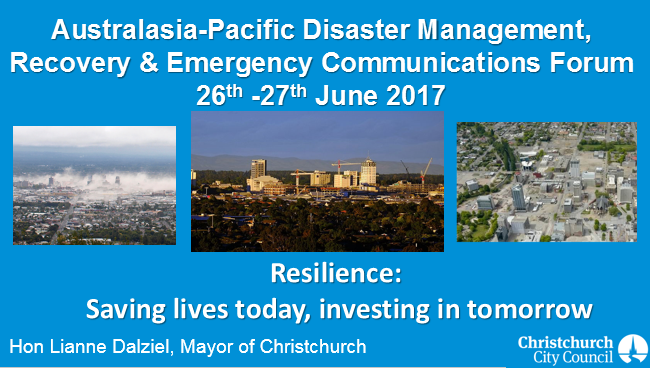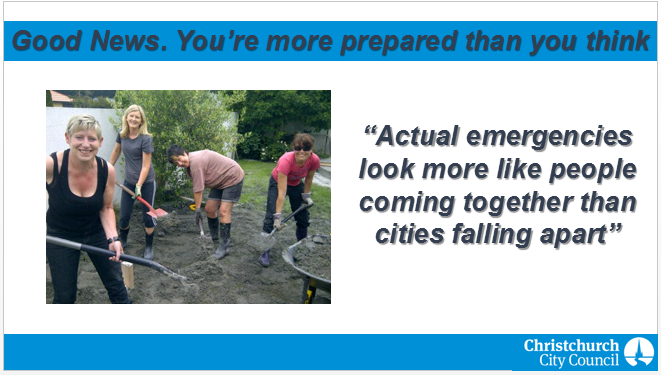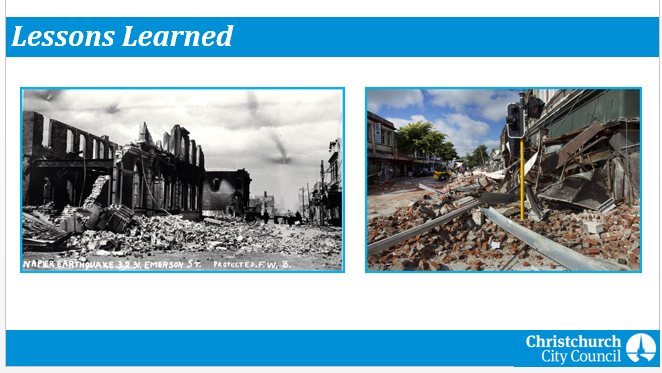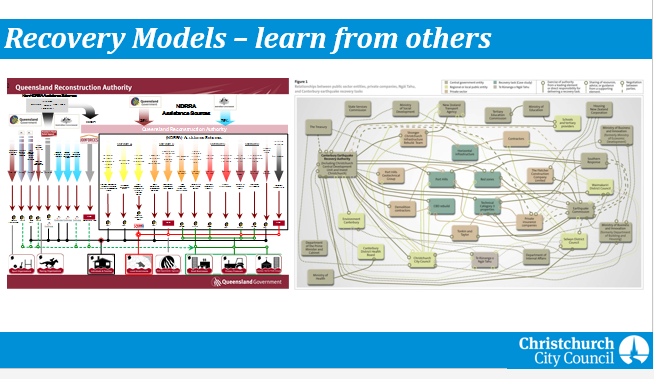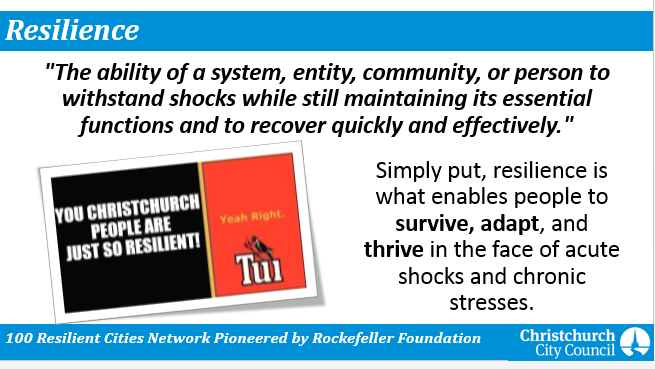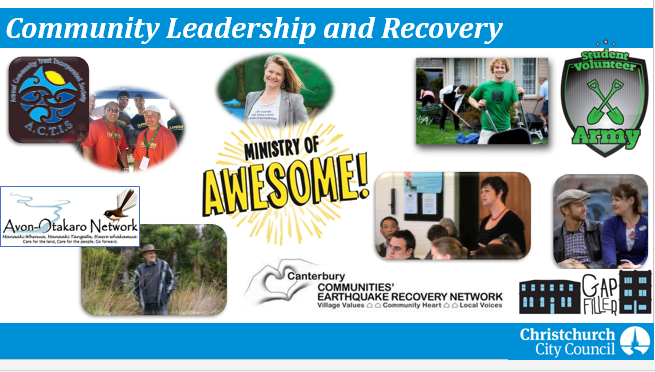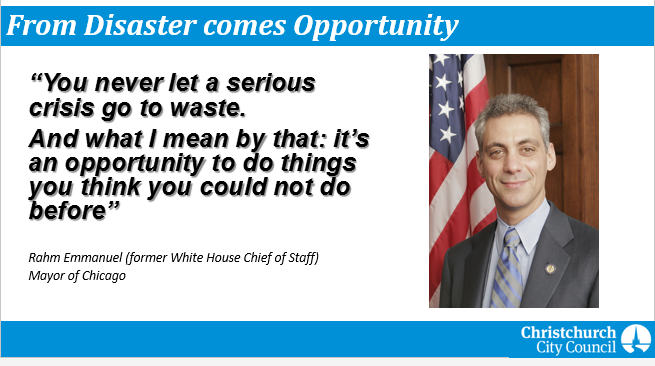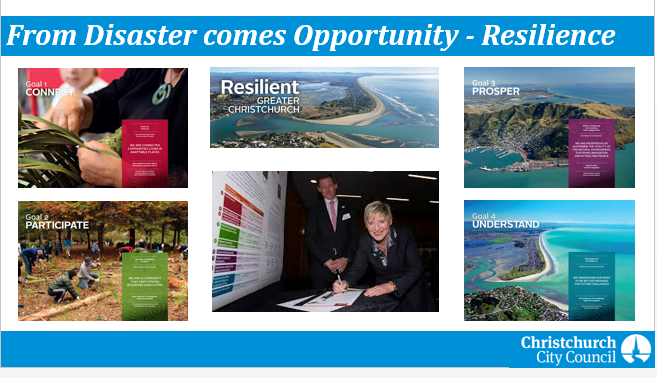I have taken as the theme of my welcoming address the words I found on your website. Resilience: Saving lives today, investing in tomorrow.
As your programme highlights, “To build a resilient Asia-Pacific requires a paradigm shift from a response-recovery governance to a risk-sensitive development approach, and a stronger regional co-operation for managing trans-boundary disasters.”
People lie at the heart of this conversation – building resilient communities is not something governments can do for communities, but it is not something that all communities can do on their own. Co-operation and collaboration lie at the heart of a planning and decision-making environment that promotes risk awareness and risk reduction, together with better preparedness, readiness, response and recovery. I have said many times that we prepare for the immediate response to disaster but not for recovery – and that’s where building resilience comes in.
The headline – Good News. You’re more prepared than you think and the quote: actual emergencies look more like people coming together than cities falling apart – both come from the San Francisco emergency preparedness website. And they are very accurate. There are things we do as cities or regions or communities that prepare us for an emergency, but what I have come to realise is that is true of preparedness for recovery too. But we don’t always see them.
I attended a recovery seminar shortly after the February earthquake and heard one of the speakers say that it was vital to understand the pre-existing story – what was going on before the disaster struck. He was referring to identifying pre-existing vulnerabilities, given that disaster can present an opportunity to address those. I now know it to be equally true of pre-existing strengths – the building blocks of recovery and resilience.
My message today is how important it is to recognise these building blocks as preparedness initiatives when considering a Disaster Risk Management framework, because they can shape both the nature and the speed of recovery and build resilience at the same time.
Many of the first people who died in Hawke’s Bay, were those who ran out of the buildings and were crushed in the rubble.
We gained a lot as a country from this and subsequent disasters and WWII. Our national disaster insurance scheme – the Earthquake Commission – our building code and our Standards Council.
But somehow the risks associated with unreinforced masonry, parapets and decorative features were not picked up.
I remember meeting a man who had moved to Christchurch from Napier about 30 years ago. He said he thought there was something different about Christchurch houses when he arrived – he realised it was chimneys.
So we didn’t know that we were exposed to earthquakes? We did. Maybe like me everyone thought the big one would be Wellington. But we had September – why weren’t we thinking about what we could do to de-risk our city? Maybe we knew to expect a one magnitude below and it hadn’t come – this was nearly 6 months later – maybe we thought a smaller magnitude earthquake couldn’t do more damage than the first one in the sequence.
I say this because it is so vital to learn the lessons of each experience and embed them into our regulatory frameworks, because people forget.
It is also very human to think that you are the only person in the world who has had to confront a particular issue or challenge. But the truth is there is much we can learn from the experience of others. The regional co-operation that you have identified as so important is absolutely vital.
It seemed to me early on that we needed to focus on building community resilience, not only with respect to a particular event, but also in case the decision-makers don’t get the recovery framework right.
At the community level these all speak to the building of social capital. I always say that a community is not defined by the co-location of houses – that’s a suburb – a community is defined by the relationship between people who belong to the community – be it based on place, identity or interest – and the decision-makers that can affect their community – be that local or central government or both.
So what builds that social capital?
I have used Project Lyttelton as an example – it has Welcome Bags for new community members, community gardens, farmers market, runs festivals, fruit and vege collective – the list goes on, but most importantly it has a timebank. You don’t need a civil defence group when you have a community that already values other members contribution equally – hour for hour not based on dollars. And here are the reasons why this builds social capital.
Timebanking is based on 5 Core Values:
1.We are all assets. We all have something to give. The real wealth of a society is its people. Every human being can be a contributor, no matter who they are and what their experience in life has been.
2.Redefining Work: Some work is beyond price. Work has to be redefined to value what it takes to raise healthy children, build strong families, revitalize neighbourhoods, make communities work, advance social justice, and make the planet sustainable. That kind of work needs to be honoured, recorded and rewarded.
3.Reciprocity: Helping works better as a two-way street. The question: “How can I help you?” needs to change so we ask: “How can we help each other build the world we both will live in?”
4.Social Networks: We need each other. Networks are stronger than individuals. People help each other re-weave communities of support, strength and trust. Community is built upon growing roots, building trust and creating networks.
5.Respect: Every human being matters. Respect underlies everything we value. Respect supplies the heart and soul of community. When respect is denied to anyone, we all are injured. We must respect where people are in the moment, not where we hope they will be in the future.
SLIDE
ACTIS – as with the Lyttelton Project, ACTIS had been practising grassroots community development for a decade when the earthquakes struck. The truth is that this community would have taken much longer to respond and recover if it had not been for this community trust that had the confidence of the community and the capacity to sit at the table with central and local government.
The Avon-Otakaro Network – was established to enable the community to be directly involved in the future of what is called the Residential Red Zone – over 7000 properties were once part of the river and estuary side communities that were affected by the earthquakes.
Sam Johnson will always be associated with the emergence of the Student Volunteer Army that played such an important role in engaging students in the response effort after the earthquakes. The spirit it engendered has become an integral part of the University of Canterbury’s curriculum.
Gap Filler – is just one of the emergent groups that give life to vacant spaces and have given meaning to the phrase the art of recovery.
The Ministry of Awesome is awesome – the introduction of new ideas and new ways of working has spearheaded innovation and creativity as part of the transition and embedded them into the future Christchurch.
CanCERN – Canterbury Earthquake Recovery Network – was a vital mechanism for bringing a range of community and residents groups together so they had a voice that could influence the decision-makers. Their motto was “The wisdom of the community always exceeds the knowledge of the experts.” I personally think that this was a reaction to being excluded and I will come back to that in a minute.
We are connected communities living in adaptable places
We are a community that participates in shaping our future
We are prosperous by sustaining the vitality of the natural environment, fostering innovation and attracting people.
We understand our risks to be better prepared for future challenges
There are many elements to achieving these goals but I think that you will see that all of them are about mutual actions.
Resilience is not a top down exercise, but nor is it grassroots up alone. It has to be both. I said I would come back to the CanCERN motto – the wisdom of the community always exceeds the knowledge of the experts – I believe it should say – the wisdom of the community when combined with the knowledge of the experts always exceeds what one can offer without the other.
Each of these goals requires a clear shift in how we engage people, not as taxpayers or consumers, but as citizens with rights and responsibilities. Focusing on community led organisations and community leaders feature throughout the plan.
For me one of the great lessons of our experience is that leaders will always emerge from communities and they must be engaged as soon as possible. They already have the trust of their communities and trust is the one ingredient that we cannot do without if recovery is to be successful and if we truly want to build resilience. And as you’ve seen many of them are already there. They should be treated as a critical part of the resilience of the city’s social infrastructure in the same way we treat our physical infrastructure – the buildings, roads and pipes. We need to be able to rely on both after disaster strikes.
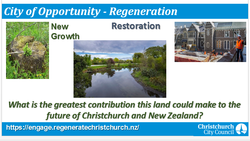
Regeneration is a wonderful word – it blends the concepts of restoration and new growth. The old recovery model, with the spaghetti junction image, has been disestablished and we have a new regeneration framework, which has community engagement at its heart. And that in of itself will continue to build resilience.
The future of what is called the Residential Red Zone is one of those amazing opportunities a city could ever have to rethink an area of more than 600ha – half of it is twice the size of Hagley Park.
So thank you for choosing Christchurch for this forum. You can see that I believe that building resilience to disasters is the path forward – and that it is the only way that we can save lives today while investing in tomorrow. We must learn the lessons of our experiences and we must be willing to learn the lessons that others have experienced. That is how we build resilience within our communities and cities and how we build resilience within our region.
So welcome to Christchurch and welcome to one of the most important conversations we need to have.

